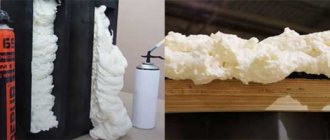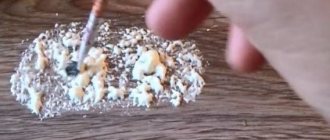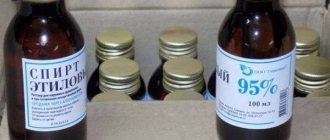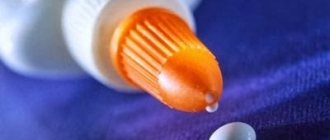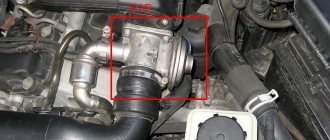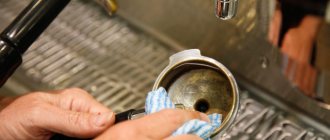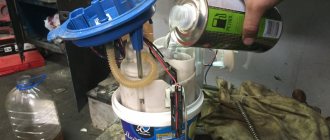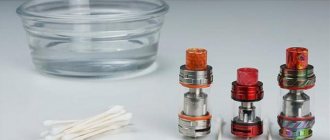The foam gun must be washed after each use in order to be able to work with it in the future. Instrument cleaning techniques will depend on the variety:
- Metal models. Durable, reliable, can be used for 3-5 years. Easy to use and easy to clean sealant.
- Teflon models. The gun has metal surfaces that have a Teflon protective coating. This makes the tool easy to clean.
- Plastic models. They are only suitable for one-time household use, so there is no point in cleaning them after completion of work. This is a cheap and affordable tool that is sold in any hardware store.
Therefore, it will be much more profitable to buy it every time you need to work with polyurethane foam. If you frequently work with sealant, it is recommended to buy metal or Teflon models, which already require systematic cleaning.
Methods for cleaning a gun from hardened foam
Before cleaning the gun from polyurethane foam, you need to decide on a cleaning technique. There are several ways:
- Mechanical cleaning. It is necessary to disassemble the tool and carefully and consistently clean all elements. To carry out the work, removers (for example, regular acetone), a knife, a rag or a sponge are used.
- Cleaning using a chemical reagent. Tools are cleaned using chemical mixtures. Carried out upon completion of the work process and removal of the can. This method is suitable if the gun has been used for a short time.
- Cleaning without removing the can. The traditional method, which is used when the tool is used frequently and the cans of polyurethane foam are constantly changed due to the consumption of sealant.
How to clean the nozzle on a cylinder
To remove the mounting foam, remove the sealant column from the fitting directly on the cylinder (the upper part where the nozzle is fixed). Carefully screw in a self-tapping screw whose diameter is smaller than the hole. Next, pull the screw - foam will come out with it. After this, lightly squeeze the fitting - when the hiss of escaping air is heard, the cylinder can be used in the future, since the foam in it remains under pressure. The nozzle is cleaned according to the following algorithm:
- The nozzle consists of an adapter and a long tube, which is disconnected from the second part. This manipulation is not difficult, since the elements are inserted into each other.
- The tube is cleaned using a long self-tapping screw, which is used to pull out foam columns in turn from 2 sides. The remaining foam can be pushed out with a knitting needle.
- The adapter is cleaned of mounting foam in the same way as the tube.
For reference! To release the tube, this element is gently kneaded - fingers are squeezed in the areas where foam remains. Air bubbles in the foam will come out and the column will decrease.
How can you clean foam guns?
The method of cleaning the gun from dried foam is selected depending on the level of contamination of the tool. The simplest solution is to remove all contaminants immediately upon completion of the work. In this case, you need to remove all visible remains of the mounting foam from the tool and clean the barrel.
If the tool is heavily soiled and mechanical and chemical cleaning methods do not help, then you need to consider purchasing a new gun. Especially if the life of the old tool exceeds several years.
Standard option
When using the standard mechanical cleaning method, you will have to completely disassemble the gun:
- You need to unscrew and remove everything you can. If the tool is expensive, then there must be instructions for it, which indicate the design features. The main thing is to take care of threaded connections during disassembly.
- When disassembling the gun, you need to remove the sealant from all elements, wiping them dry with a rag.
- To blow through the barrel, it is recommended to use a cleaning rod (you can make it yourself from metal wire).
- At the next stage, a flushing compound is poured into the barrel and everything is cleaned with a cleaning rod. The process of cleaning the barrel must be repeated until the cleaning rod moves freely in the barrel. If the mounting foam dries in the barrel, it will not be possible to remove it only with a chemical composition.
- It is very important to completely remove the sealant from the barrel, since during subsequent work the movement of a new portion of the consumable may be difficult.
- After cleaning the gun, you need to lubricate the connecting parts and assemble the tool.
Disassembly and repair
During repair work outdoors and in autumn or winter, you should always check the cylinder and its internal filling. If the foam freezes, it will not be able to come out of the nozzle, even if the trigger is pulled gently.
To clean the gun, it is recommended to buy an additional flush or use acetone. The disassembly procedure consists of several stages.
All remaining foam is removed from the outside of the gun. The adapter for the cylinder is unscrewed and washed thoroughly. Clean the inside of the valve with a cotton swab. Using a wrench, remove the rod, rod and end of the nozzle. The bolt is unscrewed and the cap is removed from the gun. The adjustment bolt is removed and the rod is removed. All the insides of the instrument are thoroughly washed, it is especially important to treat the mechanisms. In case of component failure, parts are replaced.
After cleaning or repair, the gun is assembled in the reverse order. Experts advise doing cleaning work once a quarter if the equipment is used constantly. Repairs and cleaning may take several hours, but this saves money on foam canisters, and also helps ensure high-quality tool performance and uniform foam extrusion.
To properly carry out repair work and disassemble the gun, it is recommended to watch the video, which shows all the details and gives step-by-step instructions:
Before disassembling and repairing the gun, it is important to understand the main causes of breakdowns and malfunctions of the tool. In some cases, the problem is hidden not in the gun, but in a low-quality cylinder with mounting mixture
Causes of malfunctions
To ensure long service life of the tool, it must be used correctly and properly maintained. If you need to do extensive repair work, then it is better to buy high-quality products, expensive professional or semi-professional models.
The drying process of the foam and the quality of work are influenced by the amount of mixture squeezed out, the speed and pressure created by the gun. Disassembly of equipment may be required in the following cases:
- the pistol is full and has been left without a cylinder for a long time;
- the adjustment valve is left in the open position for an extended period;
- until the next work, the tube with foam was not removed from the gun;
- malfunction of the valve, which is installed on the gearbox;
- the trigger is pulled without a cylinder;
- The device is not cleaned after work.
The most common cause of equipment malfunction and the need for disassembly is dried mounting mixture inside the instrument. In this case, the mechanisms become clogged and cannot work normally. Even if the foam comes out through the nozzle, its flow will be uneven. Impacts to the equipment and dropping the gun can have a negative impact on operation.
In accordance with applicable law, the Administration disclaims any representations and warranties that may otherwise be implied and disclaims liability in relation to the Site, the Content and its use. More details: https://seberemont.ru/info/otkaz.html
Was the article helpful?
Tell your friends
What to do if the gun barrel is filled with dried foam?
If you failed to clean the gun and remove the mounting foam in time, it will dry out. Cleaning with a cleaning rod will no longer work. In such situations, the trigger mechanism also does not move. If this happens, it is recommended to carefully clean the nozzle, remove all sealant from it, and coat it with solvent (the barrel must first be lowered). In some cases, after this the trigger will move.
If the trigger mechanism still does not move, it is recommended to do the following:
- There is a small ball in the area where the sealant can is attached to the tool.
- You need to apply a solvent to this ball. This will help clean the bypass valve if it is heavily clogged with foam.
- After 20-25 minutes, you need to attach a bottle of cleaner to the spray foam gun and use it to rinse the barrel.
Experts recommend stocking up on a bottle of cleaner if you intend to use a pistol. Thanks to this forethought, you can quickly clean out all the foam that has not yet dried out of the tool, ensuring its long-term and trouble-free operation.
If the polyurethane foam has seriously hardened, it is not recommended to try to clean the tool with force (especially if a Teflon model is used). With rough mechanical cleaning there is a high probability of damage to individual structural elements.
If, upon completion of the work, the gun is very dirty and it is assumed that the foam has already hardened inside it, then before starting cleaning you should not press the trigger mechanism. Such manipulations can easily break it.
Types and possibility of cleaning
Foam guns are divided according to the conditions of use into household and professional. The models that are constantly used by builders are dismountable and it is possible to clean their structural elements after dividing the tool into main parts. Models for household use generally have a non-separable design, which makes them difficult to clean from dried foam and reuse. When choosing a tool, it is necessary to take into account the technical characteristics that determine the ease of use of the gun. The main characteristics are the ability to maintain tightness, the material of the mechanism body and its key structural elements.
Ensuring tightness is a parameter that determines the quality of the device and its operating parameters: dosing accuracy and the likelihood of the mounting compound hardening in the tool. The main material, in the case of professional models, is metal and impact-resistant plastic. There are 3 main categories of materials from which the mechanism is made:
- Metal is the most durable option. The operating period of models with a metal body is the longest. The average duration of use of such a mechanism is 5 years. These models are also easy to clean, as the body is impact-resistant and the likelihood of damage is minimal.
- Teflon – the tool has metal surfaces that are coated with a protective Teflon layer. This coating simplifies the process of cleaning the mechanism from hardened polyurethane foam. But during the manipulation, great care is needed. Otherwise, the cleaning method is no different from that used for metal models.
- Plastic - when the material is not impact-resistant, such a tool is disposable and it is impractical to clean the mechanism.
Attention! The simplicity of the design of professional models of mounting guns is not a reason for refusing to follow the rules for cleaning the tool. Timely cleaning avoids inconvenience and difficulties during subsequent uses.
Rules for cleaning a gun from dried foam
If you intend to rinse the gun from foam, then you must follow some rules when carrying out cleaning work:
- Upon completion of work, you must immediately clean the tool barrel of any adhering sealant. This can be done using any available tools, but carefully so as not to damage the control valve.
- The nozzle and valve must be lowered down when performing cleaning operations. The trigger mechanism must be treated with Dimexide. After 2-3 minutes, you need to lightly press the trigger mechanism. If its vibrations are noticeable and foam flows from the nozzle, then the tool is ready for further use.
- If nothing happens, then you need to find a small ball in the area where the sealant can is attached. It must be treated with Dimexide, then insert a bottle with washing liquid and perform the rinsing. Upon completion of flushing the foam gun, you can press the trigger mechanism - everything should work.
If the methods listed above do not help, then complete disassembly of the pistol is recommended. All parts must be treated with solvent and dripped into the sockets. After about 10-15 minutes, the remnants of dried polyurethane foam will begin to give in, so they can be quickly removed with a rag. After assembling the tool, it must be treated with a reagent.
This cleaning method is relevant if more than 5-6 hours have passed since the completion of the work. The polyurethane foam hardens during this period, so it will have to be cleaned mechanically.
On video: Washing the gun from polyurethane foam.
Design and variety of pistols
Polyurethane foam is sold in a liquid state under pressure in sealed containers. Release is carried out using disposable plastic nozzles (household version) or a separately purchased gun (professional or semi-professional type). In both cases, the device of the foam gun is represented by a tube and a trigger mechanism.
Design features
Although the principle of operation of the nozzles is similar, they are noticeably different in structure, composition and functionality. Thus, structurally, separately purchased tools are divided into 2 types:
- One-piece.
These are plastic samples with a metal rod for distributing the working mass. Such models are classified as semi-professional pistols for performing tasks within 1-2 days.
They are relatively inexpensive, but difficult to clean and cannot be repaired. The main reason is the integrity of the structure and high adhesion of polyurethane foam to polymer materials. That's why professionals consider them disposable.
Disposable gun type Source prom.st
- Collapsible.
Here, practicality is explained by the possibility of free access to individual components of the tool. In case of clogging or sticking of the foam to the inner walls of the structural elements, you can remove dry residues and clean the tubes.
This is a professional type of pistols that consists of two prefabricated parts. Here it is possible to replace individual elements and repair the instrument as a whole.
The table provides a brief overview of the individual components of the pistol.
| Component | Functional significance |
| Trunk | The task of this structural element is to supply and adjust the direction of dispensing polyurethane foam to a specific work area. |
| Trigger | Transfer of action to the built-in mechanism in the cylinder. When the trigger is pressed, the working mass is released from the cylinder into the barrel. |
| Pistol (grip) | The most convenient (ergonomic) part of the tool that fits in the palm of your hand. The more comfortable it is for the user, the better the control of the tool and the foaming of the object as a whole will be. |
| Adapter | If we draw an analogy with a weapon, then this structural element acts as a clip for cartridges. Here the device is charged for subsequent release of polyurethane foam to the work area. |
In addition to the basic components, there is a fixing screw. It acts as a regulatory mechanism regarding the supply of polyurethane foam.
Gun with adjusting screw Source karkas32.ru
That is, the mass feed rate and its volume are adjusted. There is a tip on the barrel - a fitting. The only distinguishing feature can be the diameter of the passing hole.
See also: Catalog of companies that specialize in finishing materials and related work
Operating principle
It is worth noting in advance that before releasing the polyurethane foam, it is necessary to perform 2 steps. It doesn’t matter whether this is a household option or whether this or that gun is used. Initially, it is necessary to place the cylinder in a room with a positive temperature for at least 6 hours. The second step is to thoroughly shake the liquid mass. Shaking is carried out approximately 15-30 times in the up and down direction.
Next you need to do the following:
- fix the tool using threaded connections until there is tight contact (the signal here will be a characteristic hissing sound - the release of air or foam);
- press the trigger in a smooth motion;
- point the barrel at the working base.
The gun and cylinder are ready for use Source master-plus.com.ua
When the trigger is pressed, the process of foaming the polymer liquid and the primary stage of its expansion occurs. Due to the pressure set in the cylinder, the foam is released through the fitting under acceleration. On the surface, the working mass increases in volume again by 60-90%. The efficiency of the tool is adjusted by the degree of pressure on the trigger and the adjusting screw.
How can I clean the gun?
Mechanical cleaning of the instrument and disassembly is a radical method, but effective. If the mounting foam has frozen inside the gun, then it is unlikely to be completely removed from the cavity of the tool. Therefore, with each subsequent use, the output flow power of the sealant will weaken, as the substance will cling to frozen residues.
If the sealant has hardened, then it can be cleaned from the hardened polyurethane foam using the washing method. In this case, you need to act quickly and prudently. You need to buy a special cleaning composition.
Washing the instrument is carried out in the following sequence:
- The can of sealant is removed, and a can of cleaning mixture or aerosol is installed in its place.
- Then you need to press the trigger mechanism - liquid will flow from the barrel of the tool. You must hold the trigger until the liquid becomes completely clear (this indicates that the hardened sealant has been dissolved).
- The canister with the cleaning mixture must then be removed and the trigger mechanism pressed again. If the trigger moves jerkily, this will indicate insufficient cleaning. Therefore, all manipulations must be repeated.
How to carry out the procedure
How to cleanse
The degree of contamination of the construction gun will determine which cleaning method you use. The simplest and most accessible option for everyone will be the one that is used when it is possible to eliminate contamination immediately after using the unit. In this case, it is necessary to remove visible particles of the gun, as well as to force out the residual mass of sealant from the barrel.
Mechanical cleaning involves complete disassembly of the instrument:
- You need to unscrew and get out everything that is possible. The instructions that come with the device must contain detailed instructions on how to clean the gun from contaminated foam. When working, you should carefully remove and unscrew everything so as not to tear or damage the threads.
- When disassembling the pistol, you should clean all existing parts from foam, and then wipe them dry with a soft cloth, and also blow out the barrel. For such purposes, it is better to use a ramrod, and you can make it yourself from any available means, for example, from wire.
- Pour a special liquid into the barrel, “flushing”, and then clean the tube from any remaining foam using an improvised rod. Repeat all the manipulations until the cleaning rod moves easily in all directions and its tip appears on the other side. If the foam has dried in the barrel, then you will not be able to remove it with just a chemical substance.
- The barrel should be cleaned very carefully so that in the future, residual foam does not interfere with the passage of the new polyurethane foam type sealant.
- When cleaning the tool, you should lubricate its connection points and perform assembly.
- After all manipulations, the tool is ready for use.
Please note that you should only perform such actions if you have an idea of how the device was designed. If you do not have such information, we recommend that you seek help and advice from specialists.
Disassembling a pistol is an extreme case, and it is better to avoid putting all equipment through such procedures. Even after thoroughly cleaning the gun, new sealant may not come out of the nozzle properly, rendering the gun useless.
There is another cleaning method, and it is used if the gun barrel is completely clogged, and in addition to this, the adjustment lever (i.e. the trigger) is not depressed. In this case, you should carefully clean the nozzle from foam and sealant in general, and then lubricate everything with a solvent. The barrel must be down. After a few minutes the lever should begin to move. If everything worked out for you, then you can continue cleaning further.
If it turns out that the adjusting mechanism cannot be moved, then use the third method. There is a small ball in the area where the container with the foam enclosed in it connects to the gun. It is this that should be treated with a solvent. Such actions can really help with cleansing if the foam is heavily clogged in the bottle of cleaner, and then clean the barrel with all the contents.
So, based on everything listed above, you can conclude that when starting work with a gun for installation and sealing with foam, you should always have a “gun first aid” with you, namely a bottle of cleaner. Forethought will help you timely clean expensive equipment from remaining foam that has not hardened, as well as extend the service life of the device. If the sealant has already hardened, keep in mind that using brute force can damage the gun, especially if you have a Teflon type. In such a case, the device will simply become unsuitable for subsequent use.
If, after completing the work, the tool still remains dirty, and there is also a possibility that the foam will have time to harden, then before performing the procedures for cleaning the mounting gun from foam, you should never pull the trigger, as this may break mechanism.
You should clean the gun from the mounting foam that has managed to harden as soon as possible, following certain rules:
- Immediately clean the barrel of any sealant that has stuck to it. For these purposes, you can use a knife, but keep in mind that cleaning should be done extremely carefully so that the valve is not damaged.
- The gun nozzle/valve must be positioned straight down. The trigger mechanism should be filled with a substance such as Dimexide. Next, after a minute, try to lightly press the adjustment lever, and if it begins to oscillate and the sealant flows from the nozzle, the gun can continue to be used. If nothing like this happens, then you will need to proceed to the next step of removing the sealant that has accumulated in the hole.
- There is a small ball near the place where the balloon connection is made. It is necessary to apply a little product (Dimexide) to it, and then attach the bottle containing the cleaner. After a couple of minutes, try to pull the trigger.
Please note that if for some reason none of the methods described above helped, you should completely disassemble the instrument, and then drip solvent (or the same Dimexide) into the socket and into each internal part of the device. Next, after 1/3 of an hour, all the remaining mass that has hardened will give in easily, and you can wipe everything off with a rag. After assembling the gun, you should wash it with a reagent.
This removal method should only be used when more than 8 hours have passed since completion of work. During this time, the foam can dry 100%, and therefore the instrument should be cleaned mechanically after eight hours. After such cleaning, the device will be able to produce much less pressure than before. For this reason, you should take care of the device and its cleanliness in advance, remove all foreign matter as quickly as possible, before it has time to dry.
But there is another method that makes it possible to avoid mechanical cleaning and complete disassembly of the device, due to which the gun nozzle will always be in working condition. To do this, you will need a tube, preferably a plastic one (you can remove it from the tool for one-time use), good wire, and the gun itself.
Using a wire, you should hook the plastic tube and attach it to the nozzle of the device, and after working with the gun, simply remove it. For further use of the gun, you should take a new plastic tube, and thus the tool will always be ready and clean for new work.
How to wash a gun
The mechanical method is a fairly effective way to clean the gun from polyurethane foam. But if the foam has time to harden in the cavity of the barrel, then it will be difficult to remove it completely, just all the particles. As a result, with each further use, the pressure of the foam will become less and less, since the new sealant will constantly cling to the remaining fractions of the substance. To solve the problem, you should promptly remove residual foam, and if you have started the situation, wash the equipment.
You will be able to perform high-quality cleaning of the gun from hardened polyurethane foam by washing if you can follow two basic rules - speed and forethought. Such moments mean that you should buy special products for cleaning and quick use. Experts advise buying cleaning products from the same company as the manufacturer of polyurethane foam, and working only in tandem of the same name.
Important! When the application of the sealant is completed, you should immediately, without delay, begin to clean the tool. Remove the used container, and if there is still foam left in it, do not throw it away - the substance in the container will retain its positive properties for a long time.
Washing the mounting gun is carried out according to simple rules:
- Remove the bottle containing the sealant, and instead, fix the bottle containing the cleaning aerosol.
- Pull the trigger. At the same time, liquid should begin to drip from the spout of the device. Keep it pressed until the stream becomes clear - this is the main sign that the cleaning agent has managed to dissolve the hardened sealant.
- The cylinder should be removed and triggered again. If for some reason it moves jerkily, it means that it was not possible to wash off all the dirt and you need to repeat the procedure again.
Please note that according to safety rules, when washing, the barrel of the instrument must be directed away from the person so that the cleaning composition does not get on his skin and mucous membranes.
The fact is that the solvent can leave a burn on the body, and therefore when working with it you should be extremely careful and attentive. Please note that you should not smoke near the cylinder, store it in the sun, near a fire, or open the container. If the substance gets into your nose, mouth or eyes, you should definitely and immediately seek help from a doctor.
If you wish, you can replace the aerosol remover, and if you don’t have any product at home, you can use acetone instead. Pour it into the nozzle of the device, and then use an iron wire to clean the gun. It should be washed slowly so that all parts remain undamaged and intact.
Safety precautions
Regardless of what cleaning composition is used and how the gun is cleaned from polyurethane foam, during cleaning work the barrel of the tool must not be directed towards people or animals. The sealant is under pressure, so there is a possibility of it coming into contact with the skin and eyes.
You need to be especially careful when using a solvent to clean polyurethane foam. Such compositions are caustic and can cause serious chemical burns if they come into contact with the skin.
It is prohibited to clean the instrument near an open flame. It is not recommended to smoke in the room where foam is applied or tools are cleaned with solvents.
If solvents and cleaning compounds accidentally come into contact with the skin, the area should be thoroughly rinsed with running water. In case of contact with mucous membranes, it is strongly recommended to immediately contact a medical facility.
?using a cleaner
The most common cleaning option is using a special liquid. In this case, it is better to obtain a solvent from the same manufacturer. For complete cleaning, do the following:
- remove the used cylinder;
- remove the protective cap from the aerosol cleaner;
- secure the solvent canister and pull the trigger of the gun until the remaining foam disappears.
Finally, remove the container with the cleaner and inspect the free movement of the trigger. If the solvent has not been completely used up, then it is stored in the original container, again putting a protective cap on the container.
Care instructions
The gun must be cleaned immediately after use - it is not recommended to delay these manipulations, because after a few hours of completion of work it will be much more difficult to remove the hardened sealant. Guns usually break due to clogging with dried foam. The following areas are most often clogged:
- Check ball.
- Spout of the can.
- Supply valve.
These are mechanical failures, so to fix them you need to disassemble the gun and clean it. If the sealant sticks to the tool barrel, you will have to use a foam solvent. It perfectly dissolves dried foam in the gun.
If the gun is not used for a long period of time, it is recommended to clean it systematically (every few months) for preventive purposes. This will extend the life of the tool.
To not clean at all
With a good and experienced owner, the gun practically does not clog. He knows the secrets of proper operation of the unit:
Read also: Recipe for early ripening pancakes on water
- the foam along the muzzle should flow smoothly, evenly and slowly; rushing will not lead to the desired result;
- after use, remove the foam immediately, do not wait until it hardens (you can do this by placing the unit under a strong stream of water - the mixture will come out. But be careful: it can clog the sink);
- after washing with water or solvent, wipe the device with a dry cloth;
- store the product in a dry, warm place away from moisture and direct sunlight;
- Too frequent disassembly of the pistol leads to its premature failure.
With normal use, a metal device will last 5 years, a Teflon device will last 10 years, and a plastic device will last 12-18 months.
With proper care, a quality foam gun will last about 5 years. It makes sense to treat the instrument with respect
Tips and tricks
Craftsmen who constantly use a gun always keep it clean, because repairing and buying new tools is too expensive. It is much easier to clean the gun from foam deposits in a timely manner.
Any contamination must be removed as soon as the surface treatment is completed. Due to timely cleaning, the instrument can last for several years (especially Teflon models).
The choice of method for cleaning foam will depend on the contamination, as well as how long ago the work was completed. If the work was carried out several tens of minutes ago, then all the foam can be removed quickly with a rag.
How to clean a gun from polyurethane foam (2 videos)
Methods for cleaning a spray foam gun (15 photos)
Which model should I buy?
If the approximate consumption of polyurethane foam in the foreseeable future is no more than ten to twelve cylinders, you can purchase a cheap plastic gun. Long-term operation is not for such models. Craftsmen who plan to use the tool in the long term, but not regularly, should opt for a metal dismountable product. Teflon-coated guns are considered the most preferable for those who often work with polyurethane foam. This material is easy to clean and rinse even without the use of a special liquid. Polyurethane foam guns made of high-quality plastic have also proven themselves well. Both of these models are used, as a rule, by professionals. For home craftsmen, a regular metal model will do.
Regular cleaning of instruments
The norm is to clean the foam gun after each use of this tool. It is also recommended to clean the gun if the cylinder is replaced with foam from another manufacturer or with a composition that has a different level of heat resistance. Why is it important? The fact is that the composition of the foam may differ from one manufacturer to another. When mixing different compositions, a situation may arise in which the solvent simply cannot clean the instrument.
Tip: It is recommended to purchase a cleaner of the same brand as the polyurethane foam used. Then there will be no problems with cleaning.
If it is not possible to frequently wash the tools during work, then at the end of the working day such a procedure must be carried out.
Polyurethane foam application tool
What products are used for cleaning
To clean the mounting gun at home, acetone (a pressurized container) or nail polish remover are suitable. The pharmaceutical product Dimexide has proven itself well. The drug is non-toxic and safe for hands and tissues. Craftsmen often use white spirit. This is a special solvent that is actively used in the paint and varnish industry. Solvent, 646, 647, 649, 650, xylene are also suitable. The advantages of such funds are budget price and efficiency.
Attention! The compositions presented above have a sharp, specific odor and are highly flammable. It is recommended to pay special attention to safety precautions when working with products.
Special professional foam cleaners can come to the rescue. These are aerosol cans in which a solvent is pumped under pressure. The main active component is dimethyl ketone; various additives are used as additives.
Such products are characterized by fast action, many of them do not leave marks on plastic and PVC. With their help, you can clean not only the device, but also clothes, hands and other surfaces. The downside is that many of them only act on uncured foam. The following foam cleaners are suitable options:
- TYTAN (for hardened);
- GORVIA Cleaner;
- PENOSIL Premium Foam Cleaner;
- Remontix REMXCL4400;
- RECHT PUR Cleaner;
- AKFIX Foam Cleaner.
Certificate of conformity
The production of these drugs is carried out according to the rules of GOST, which prescribes their safe properties, and whether it is possible to use them without respiratory protection, by wearing a respirator.
In addition, the degree of flammability and explosiveness during prolonged heating is prescribed. For these reasons, when purchasing, you must request a certificate of conformity from the seller. This sign must be registered - ROSS VE.AD83.H04410. If the product has a similar designation, then the composition has passed the necessary tests, after which it was assessed positively for its intended use.
The production of these drugs is carried out according to GOST rules.
How to remove using improvised means?
Regardless of which product is chosen to remove traces of polyurethane foam, the surface cleaning process takes place in the following sequence:
Using a sharp construction blade, cut off the frozen mass from the surface as much as possible.
It is important to ensure that the blade only touches the polyurethane layer. The remaining very thin layer of polyurethane foam sealant is treated with the selected composition. First of all, use the most gentle available means. After fifteen to twenty minutes, the softened layer is cleaned off with the hard side of a dishwashing sponge.
Instead of a sponge, you can use a piece of rubber or a stationery eraser.
How to wash off old sealant with Dimexide?
A popular pharmaceutical drug with anti-inflammatory action, Dimexide, has established itself as an effective remedy in the fight against hardened polyurethane foam.
It is enough to cover the stain with a cloth, generously moistened with Dimexide and leave for thirty minutes. During this time, the frozen polymer particles will dissolve, and all that remains is to wipe the stain with a damp cloth.
Do not apply Dimexide to a foam sponge (the pharmaceutical product corrodes the foam). You can work with Dimexide only with rubber gloves (there is a high risk of chemical burns to the skin).
Sunflower oil
Vegetable oil can gently and delicately remove hardened foam from the skin. The dirt is moistened with lukewarm oil (heated in a water bath), left for half an hour, after which it is easily removed with a soft, damp sponge.
A preliminary procedure of steaming your hands in hot water will speed up the process of removing polyurethane foam sealant.
Table vinegar
Vinegar will help clean plastic and metal surfaces from dried foam. The dirt is generously moistened with a solution of vinegar and water (mixed in a 1:1 ratio) and left to soak for twenty to thirty minutes. Afterwards, the dirt can be easily removed with the hard side of a dishwashing sponge.
Pumice
A proven product - pumice - will help you clean your hands from frozen foam.
Dirty hands are immersed in warm water for thirty minutes, after which, after lubricating the skin with a thick layer of cream, they begin to scrub off the frozen foam with a pumice stone.
You need to act slowly and carefully. After the last piece of pumice is removed, hands are rinsed with warm water and lubricated with a nourishing protective cream.
Cleaning the Main Valve
It is performed without dismantling the entire mechanism. If the foam has set and blocked the lever:
- Don't push it too hard. This can damage the base frame;
- Cut the sealant from the tip of the barrel with a blade, try to make a recess;
- Drop remover inside;
- Lower the gun with the barrel down and drop solvent into the stem so that the liquid flows towards the barrel;
- Wait 20–30 minutes;
- Using progressive movements, press the hook until it is released and begins to move freely;
- After washing the lever, try screwing on a tube of cleaner and blowing through the mechanism.
If the trigger is still blocked, a complete flush of all parts is required.
